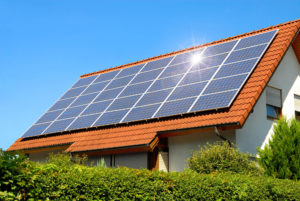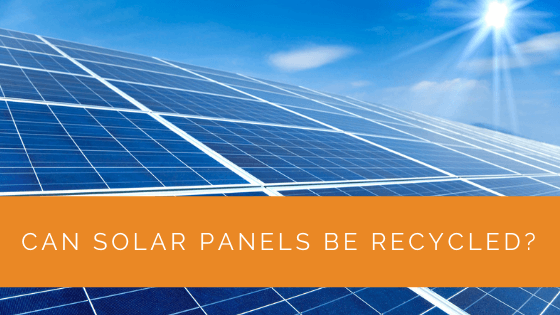Solar panels look like a sustainable way of living life. Though solar panels have an expected life of 25 to 30 years, they’ll eventually need replacing. However, you might be thinking about what happens to solar panels once they are no longer functional.
Are solar panels recyclable? The good news is that solar panels are certainly recyclable. 96% of the components from silicon-based solar panels are recyclable.
However, solar panel recycling is still at a very early stage. Most of us want to ensure that these solar panels are eco-friendly throughout our lifespan.
So, let’s discuss solar panel recycling and help you environment-conscious individuals make a better choice!
Contents
- 1 Key Takeaways
- 2 What Is the Lifespan of Solar Panels?
- 3 Solar Panel Waste
- 4 Why Is It Essential to Recycle Solar Panels?
- 5 What Is the Process of Solar Panel Recycling?
- 6 What Are the Benefits of Solar Panel Recycling?
- 7 Can You Reuse Solar Panels?
- 8 What Is the Current State of Solar Panel Recycling?
- 9 Case Study: Implementing Solar Panel Recycling for a Sustainable Future
- 10 Expert Insights From Our Solar Panel Installers About Solar Panel Recycling
- 11 Experience Solar Excellence with Us!
- 12 Wrap Up
Key Takeaways
- Solar panels are recyclable, with 96% of the components in silicon-based solar panels being recyclable materials.
- Solar panel recycling is essential because if not properly managed, decommissioned panels could contribute to hazardous waste, potentially reaching 60 million tonnes by 2050.
- Recycling solar panels has significant environmental and economic benefits, reducing e-waste and creating new green job opportunities.
What Is the Lifespan of Solar Panels?
It’s natural of you to mull over the lifetime of solar panels. It’s a common question that most homeowners have in mind while considering solar panels. According to research, the lifespan of solar panels can be as long as 30 years before they decommission.
Throughout their lifespan, the efficiency of the solar panels will depreciate up to 20% every year. In the first ten years, you’ll say a maximum 10% plunge inefficiency.
As they close 20-25 years, their efficiency will decrease by 20%. Most manufacturers mention this efficiency loss rate.
It’s also worth mentioning that many high-quality monocrystalline solar panels might offer a lifespan of 30-40 years.
Solar Panel Waste
If the industry does not realize the importance of solar panel recycling, solar panels will be responsible for 60 million tonnes of hazardous waste by 2050. Besides, it’ll contribute a large share to overall e-wastes.
It’s important to know that PV cells include a high amount of toxic substances in their structure. With this high toxicity, solar panels will no longer be a sustainable way of generating energy.
It is a common misbelief that solar panels are not recyclable. Well, that’s another myth revolving around solar panels. However, it should be a widely implemented process to tap the full benefits of recycling.
Owing to this, recycling and designing units must work closely. A well-planned recycling process would be only possible through mindful eco-designs.

Why Is It Essential to Recycle Solar Panels?
Solar panels will touch the end of their highly sustainable and valuable life after about 25-30 years. As the popularity of these solar panels is increasing, so is the amount of waste from decommissioned or broken panels.
Many studies show that solar panel waste is a threat to the environment. By 2050, solar panel waste might account for 10% of the total electronic waste in the whole world.
Besides, solar panels and it’s different components make up toxic waste. Landfills that receive electronic waste are the sources of toxic chemical leaks in the groundwater supply.
The thin-film solar panels contain more harmful and toxic chemicals in particular. In addition to having several environment-related benefits, recycling solar panels also has many economic perks.
In the coming 30 years, recycles solar panels could hold an estimated $15 billion value. Besides, upon installation in new modules, they’ll be able to generate a whopping 630 GW of power!
What Is the Process of Solar Panel Recycling?
In this section, we’ll discuss the recycling process for two different materials of solar panels. Bot silicon and thin-film solar panels have different components and, thus, different recycling processes.
Both silicon and thin-film material panels use different industrial recycling processes. Though silicone materials are more popular in the market, it does not mean that thin-film materials have no post-recycling value.
However, one same step is the disintegration of different components. Before manufacturers proceed, they have to remove the junction box, cable, and frame from the panel.
Research on solar panel recycling has resulted in various technologies. Some techniques offer as much as 96% recycling efficiency. Let’s get to the meat of the matter!
Silicon-Based Solar Panel Recycling
Silicon-based solar panels follow an entirely different recycling process than thin-film solar panel recycling. The initial step is to start the recycling process is to disassemble the structure. This step involves taking out the glass and aluminum parts.
You should know that 95% of the glass is reusable. Also, the external metal parts are suitable for re-molding cell frames.
Manufacturers treat the remaining material at 500-degree Celsius in the thermal processing unit. This step eases up the binding between different elements.
The plastic capsule evaporates because of the extreme heat. As a result, the silicon cells are ready for further processing. The innovational technology ensures that no materials get wasted in any leg of the process.
Post the thermal treatment; manufacturers physically separate the green hardware. The good news is that you can use 80% of these materials immediately. Now, the manufacturers move forward for further processing.
Manufacturers etch away the wafers or silicon particles using acid. Manufacturers melt the broken wafers to produce new silicon modules. The process is possible because silicon has an 85% recycling rate.
The process of recycling cadmium telluride solar panels is more tedious than usual. It is because the material requires several physical separation steps, metal precipitation, and chemical precipitation.

Thin-Film Based Solar Panel Recycling
Relatively, thin-film solar panel recycling is more tedious and undergoes drastic processing. The recycling process involves a shredder as well. Since thin-film solar panels have thin and flexible structures, shredding them is easier.
Afterward, the recyclers use a hammermill to ensure that all particles are 4-5mm in size or smaller. This size indicates that the lamination inside the material is ready to be removed.
Unlike silicon solar panels, thin-film solar panels have both liquid and solid material. The process includes a rotating screw to separate both the liquid and solid material.
The rotating screw retains the solid components rotating inside a tubular structure, whereas the liquid flows into a vessel. This liquid travels through the dewatering and precipitation process to retain purity.
The resulting liquid goes through metal processing to remove the various semiconductor materials. The previous step depends on the recycling technology the manufacturer is using. The good part is that 95% of the semiconductor is reusable.
Next, the recyclers contaminate the solid matter with an interlayer material. In the final step of the process, the material undergoes rinsing. The remainder of this process is pure glass. This glass is ideal for re-manufacturing.
What Are the Benefits of Solar Panel Recycling?
It’s great news that solar panels are recyclable. However, the question is, what does it bring to the table? Are there any perks of going through a tedious process like recycling?
Fortunately, solar panel recycling has extreme advantages for the economy and the environment.
Firstly, recycling solar panels will improve the scenario of e-waste. Recycling will reduce toxic solar panels, making them to landfills and contaminating nearby water resources. In short, you’re converting time-ticking bombs into profitable ventures!
Speaking of economic benefits, they are endless. The process calls for a proper recycling unit setup and the establishment of human resources. Once these are in place, the world will witness a paradigm shift in solar panel recycling.
PV recycling will also onset new green job opportunities. By 2050, the solar panel recycling industry will be worth billions.
Thanks to the solar energy price drop, more commercial and residential spaces opt for renewable energy supplies. As a result, there will be more scope for economic opportunities in the solar component recycling sector.

Can You Reuse Solar Panels?
The market for the used solar panel is booming every year. When you return the solar panel to the manufacturer due to manufacturing defects, the brand refurbishes it. If repairs are possible, the manufacturers will consider re-selling the solar panels.
The old solar panels might require a new junction box, framing, and even brand new solar cells. Manufacturers generally label the refurbished solar panels accordingly. Also, their selling cost might be 70% lower than usual.
Various suppliers mark them as ‘second-generation’ products. So yes, you can reuse solar panels. However, make your mind that it won’t be as efficient as a new one.
What Is the Current State of Solar Panel Recycling?
In America, the manufacturers of solar-powered devices take back old devices. The manufacturers can either recycle them or dispose of the decommissioned panels. Because solar panel recycling is a labor-intensive procedure, recycling them isn’t the first choice.
Also, the economics of the process might deter manufacturers from taking the recycling route. As a result, most of the solar panels end up in landfills.
If the manufacturers choose to recycle the solar panel, a glass recycling plant is ideal. The recycling process bends the specialized glass from the solar panel with regular glass.
However, most countries do not have recycling sites that cater specifically to the recycling of solar panels. The European Union issued a directive whereby electronic recycling waste, including solar panels, is mandatory.
As a result of this step, European countries can actively engage in solar panel recycling. Countries such as Japan, India, South Korea, and Australia are developing solar panel recycling.
In the US, Washington is the only state to have mandated solar panel recycling. Other states in the US have not currently made any move in support of solar panel recycling.
Case Study: Implementing Solar Panel Recycling for a Sustainable Future
Background
At Solar Panels Network USA, we prioritize sustainability in every aspect of our solar energy solutions. One of our clients, a large commercial facility, approached us with concerns about the environmental impact of their solar panel installation, specifically regarding what happens to the panels at the end of their lifespan.
Project Overview
The goal was to ensure that the solar panels not only provided clean energy but also had a minimal environmental impact when they reached the end of their useful life. This involved implementing a comprehensive recycling plan for the solar panels.
Implementation
- Education and Awareness: We started by educating the client about the lifecycle of solar panels and the importance of recycling. This included a detailed presentation on the recycling processes for both silicon-based and thin-film solar panels.
- Selection of Panels: Based on the client’s energy needs and environmental goals, we recommended silicon-based solar panels due to their high recyclability (96% of components are recyclable).
- Recycling Partnership: We partnered with a certified solar panel recycling facility to handle the recycling process. This facility uses advanced thermal and mechanical processes to recover valuable materials from decommissioned panels.
- Installation and Documentation: During the installation of the solar panels, we documented the type and number of panels installed. This information is crucial for future recycling efforts.
- Recycling Plan: We developed a detailed recycling plan outlining the steps to take when the panels reach the end of their lifespan. This plan included:
- Procedures for safely removing and transporting panels to the recycling facility.
- Information on the materials that can be recovered and reused.
- Guidelines for disposing of any non-recyclable components responsibly.
Results
- Sustainable Energy Production: The client was able to generate clean energy, significantly reducing their carbon footprint and energy costs.
- Environmental Impact: With the recycling plan in place, the client was assured that the panels would not contribute to e-waste and environmental pollution. The recycling of the panels would prevent hazardous materials from contaminating the environment.
- Economic Benefits: By planning for recycling, the client could potentially recover valuable materials, reducing the need for raw materials in the future and supporting the circular economy.
- Increased Awareness: The project raised awareness about the importance of solar panel recycling among the client’s employees and stakeholders, promoting a culture of sustainability.
Summary
This case study highlights the importance of incorporating a recycling plan into solar panel installations. By selecting recyclable panels and partnering with certified recycling facilities, Solar Panels Network USA ensured that the environmental benefits of solar energy were maximized from installation to end-of-life disposal. This approach not only supports sustainability but also provides economic advantages by reclaiming valuable materials.
Expert Insights From Our Solar Panel Installers About Solar Panel Recycling
Recycling solar panels is not just about managing waste, but also about recovering valuable materials that can be reused, reducing the need for new raw materials and lowering the overall environmental impact.
Lead Solar Installer
The technology for recycling solar panels is evolving rapidly. We can now reclaim up to 96% of the materials in silicon-based panels, which is a huge step forward for sustainability in the solar industry.
Senior Solar Technician
Understanding the recycling process and its benefits is crucial for homeowners who are considering solar installations. It’s reassuring to know that at the end of their lifecycle, solar panels can be responsibly recycled.
Solar Energy Consultant
Experience Solar Excellence with Us!
Trust in Solar Panels Network USA, where our seasoned experts deliver top-quality solar solutions for homes and businesses nationwide. With a legacy of countless successful installations and a commitment to sustainable energy, we’re your reliable partner in the solar journey. Ready for a brighter, eco-friendly future? Call us now at (855) 427-0058 and harness the power of the sun!
Wrap Up
Now that you know that solar panels are recyclable, you can rest assured of your contribution to a better environment. However, the industries are yet to show more indulgence in this process.
Large-scale recycling infrastructures are currently in the development phase. Do you know what’s more interesting? Solar panels recycling will make it possible to produce over 2 billion panels without investing in raw materials.
So, you see that solar panels are a win-win situation from all angles!
About the Author
Solar Panels Network USA stands at the forefront of solar energy solutions, driven by a team of seasoned solar engineers and energy consultants. With over decades of experience in delivering high-quality solar installations and maintenance, we are committed to promoting sustainable energy through customer-centric, tailored solutions. Our articles reflect this commitment, crafted collaboratively by experts to provide accurate, up-to-date insights into solar technology, ensuring our readers are well-informed and empowered in their solar energy decisions.

